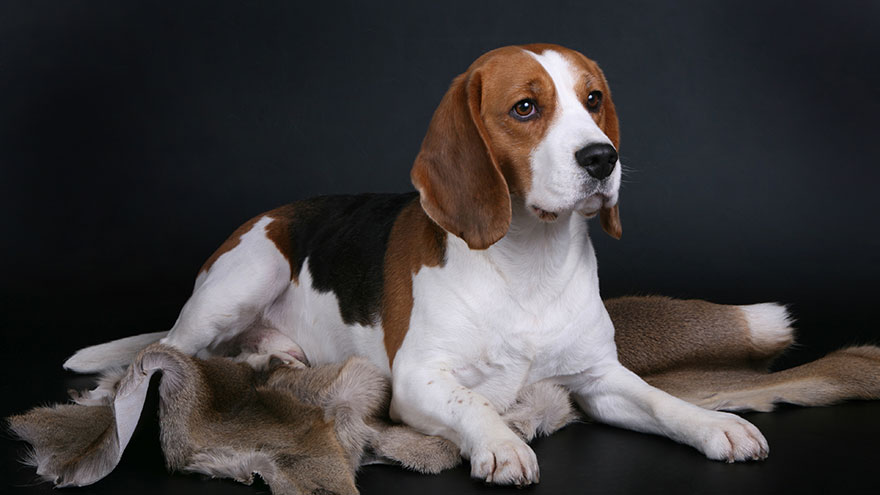Beagle : 10 Most Common Questions
While most people know the Beagle has long been used for hunting, and that the breed makes a great family pet, there are still things that potential buyers should know.
While this is an amazingly smart dog, one with a lot of energy and tons of personality, we wanted to provide you with some additional information so you can determine if this is in fact the best breed for you.

1. What exactly is a Beagle?
The Beagle is a breed of dog that originates from Great Britain. This dog has long been used for hunting, which is why it falls within the “hound” group of dogs. In fact, the official classification for the Beagle is “Group 6-Scenthounds”, which are a compact but strong dog.
2. What is the life expectancy of this breed?
This medium-sized dog reaches between 13 and 16 inches from the withers and around 35 pounds. Liters are usually not overly large, often consisting of just five to six pups. However, if the Beagle is fed a proper diet and exercised on a regular basis, life expectancy can be anywhere from 10 to 15 years.
3. How much exercise do Beagles need?
Because the Beagle has hunting instincts, energy level is medium to high. Therefore, it is important to exercise this breed at least an hour a day. Otherwise, you could end up with a bored dog that develops destruction behaviors. Long walks, jogging, or just playtime in the backyard or park is excellent.
As far as training, keep in mind that the Beagle is strong willed so you need to be patient and consistent. The only downfall with the Beagle and training is that housebreaking can be a slow process.
4. I’ve heard there are actually two varieties of the Beagle – is this true?
The answer is yes. One variety of this breed is recognized by the American Kennel Club (AKC) and the other through the Canadian Kennel Club (CKC). Although the two are very similar in structure, coloring, and temperament, the main difference is in height.
For instance, the variety with the AKC is usually between 13 to 16 inches at the withers while the CKC variety is a little bit shorter, often less than 13 inches.
5. From what I’ve read, the Beagle dates back to medieval times, what is the story on this?
Actually, some believe the Beagle dates back even further. However, this breed had a great history during medieval times when it was actually known as a Pocket Beagle due to its small size, being able to fit into a pocket. In addition, hunters would use this smaller variety for hunting, placing them in the horse’s saddlebag.
The history is that the larger variety actually would run after prey on ground at which time the smaller Pocket variety would be let loose to get under low-lying brush. Another fascinating aspect of this breed during medieval times was that Queen Elizabeth I would place this smaller variety on the table when guests were dining, letting the dog serve as the day’s entertainment.
6. Are there any serious health concerns associated with the Beagle?
Fortunately, this breed is considered an overall healthy breed. However, as with all dog breeds, there are a few considerations, which are typically, minor. For instance, this breed can have problems with the eyelashes turning inward.
You also need to make sure the inside of the Beagle’s ears are dry or the dog could get an infection, which can be treated with medication. For this, the veterinarian would simply remove the eyelashes. Other less common problems include various forms of cancer. Other than this, the Beagle is relatively healthy.
7. Do Beagles bark or howl?
They do and in fact, this breed is actually one of the more vocal dogs. Keep in mind that some Beagles are more vocal than others are. When still a puppy, you would likely hear some level of whining and/or yelping, especially when the puppy is placed in a kennel. In addition, males that are not neutered will often bark and howl at other animals.
The key here is to train the Beagle from a young age that watchdog type barking is fine but nothing more. For instance, you will need to teach your Beagle that the sound of sirens does not give it free reign to begin howling.
8. What should I expect from a Beagle puppy?
A properly bred dog will have lots of energy, be playful, and like to chew, especially during phases of teething. Typically, a Beagle puppy will love to be around people and eager to show affection.
One of the most important aspects of buying a Beagle puppy is working with a reputable breeder so you know that proper socialization has been provided.
9. Besides hunting and being used as a family pet, is the Beagle used for anything else?
Because this breed has an exceptional sense of smell, we see more and more being used in the service field. In this case, the dog might be used at an airport to sniff out drugs or illegal food, used for search and rescue in finding lost individuals,
10. I was recently told that the Beagle is often used as animal testing – was this information correct?
Sadly, the answer is yes. Because the Beagle is so passive and loving, they have been used for scientific procedures, primarily for pharmaceutical companies, medical schools, and commercial facilities. As you can imagine, this is a very difficult subject and highly controversial.
However, keep in mind that overall, as many as 100 million animals are used each year for animal research or testing.
Read More About Beagle
- Beagle Breed Information
- Beagle Training Guide
- Owning an Beagle : Breeder Recommendations
- Beagle Health Guide

